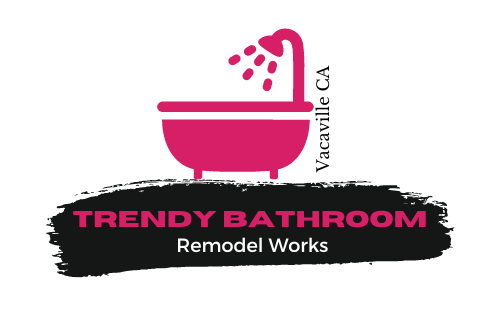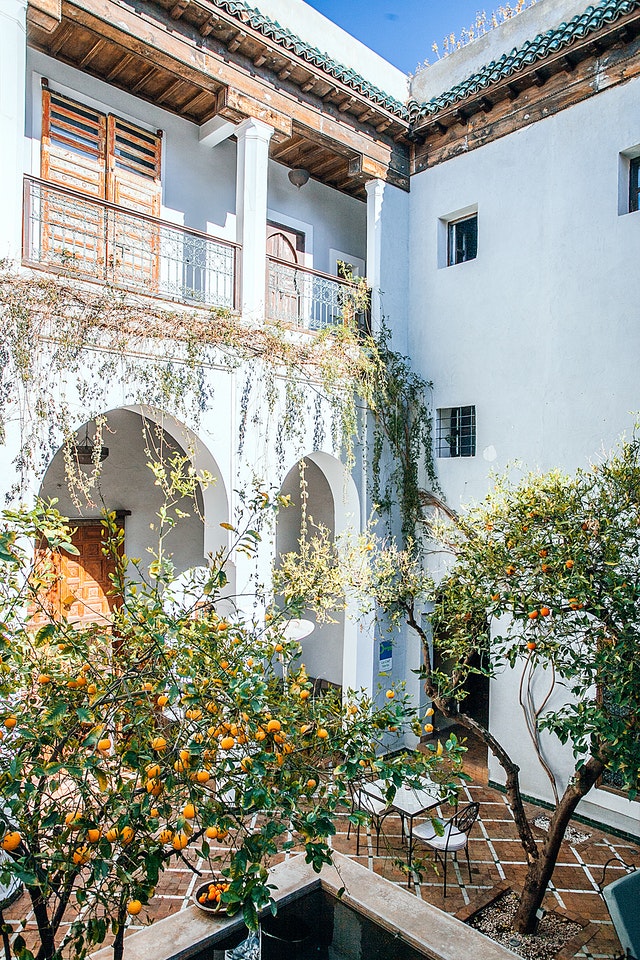Design Ideas Using Textures
This is an excerpt from the Book called “Design ideas for decorative Concrete & Stone“. Continue reading to learn more about Design Ideas Using Textures, thanks to the author.
Limestone is a sedimentary rock made mainly from calcium carbonate, a mineral that crystallizes in seawater or is formed from the underwater accumulation of shells plus tiny organisms. Waves break down these particles into fragments that, compacted with sand, mud, and clay, harden to form limestone. Travertine, a variety of limestone formed from minerals that dissolve in underground springs, is delivered to the earth’s surface by rivers, springs, and geysers. Each of these materials is white, like chalk (a type of limestone), but carbon and iron oxide create the products’ surprising colors.
Texture Terrain
Surface stunners
Creative kitchens
Bathing beauty
Outdoor splash
A spacious dressing room is reflected in a mirrored wall of a glassed-in limestone bathroom. This modern jewel-box design embraces the South-western landscape.
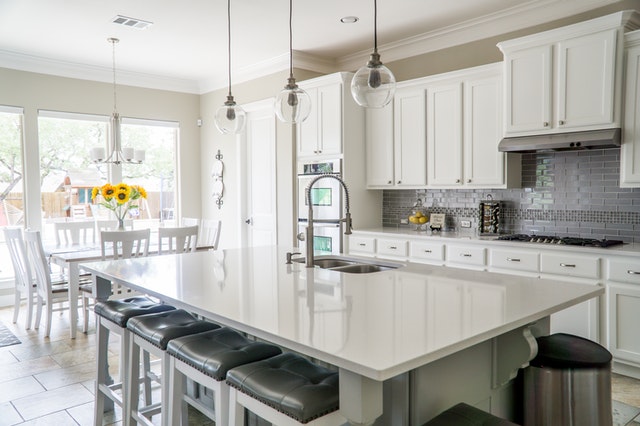
Surface Stunners
Limestone is amazingly long lasting. In ancient times it was used to construct Egypt’s fabled pyramids, just as Rome’s coliseum was built of travertine. Just as sleek and glamorous as marble, polished limestone can be slippery, which is why a honed finish is generally recommended for flooring. Limestone and travertine are known as freestones. With no preferred direction for splitting, each can be cut and carved into any desired configuration. Whether machine-sawed or hand-worked, it can answer the needs of the most demanding designs.
Pros can pull it all together
Flawless installation is the ultimate key to the appearance and functionality of any stone surface.
- Interview at least three candidates, requesting references and learning how much experience each installer has had handling your particular choice of stone.
- Insist on receiving bids in writing that include the cost of the materials and labor needed to prepare the surface as well as fabrication and installation of the product itself.
- To prevent complications down the road—in case problems arise or an accident occurs at the site—make sure your installer is licensed and insured.
Creative Kitchens
Travertine in its natural state is pocked by tiny holes that are often factory-filled with stone-dust resin to achieve smoothness. Limestone surfaces are extraordinarily smooth, with a velvet-like finish. Both materials will complement any other surface in a kitchen design, whether it’s the cloudy sheen of tempered glass, the gloss of limestone or travertine, the cool grayness of stainless steel, or the rich texture of grained wood. Where floors and countertops are concerned, the toughest stone varieties are recommended, but even they must be sealed to protect against stains and spills. What threatens the long, serviceable life of limestone and travertine the most are knives, acidic liquids, and neglect.
Handle with care
Limestone and travertine require routine maintenance:
- Do dust-mop limestone and travertine floors regularly, and blot up spills as soon as possible.
- Don’t apply tub, tile, or grout cleaner or any cleaning product whose label indicates that it contains acid.
- Do clean surfaces with a mild solution of liquid detergent and warm water.
- Don’t use any abrasive cleaners, rough sponge’s brushes, or scouring pads.
- Do protect tabletops with coasters, trivets, and placemats; flooring, with area rugs on top of nonslip mats.
- Don’t forget to apply a penetrating sealer to shield the surface. In food-preparation and dining areas, be sure that sealer is labeled nontoxic.
Bathing Beauty
A bathroom can be an ideal showcase for the use of natural stone such as travertine or limestone. Here, there is less likelihood of damage from knife cuts and acid spills. Except on the floor—where a polished surface would not be a good idea—sheen and sparkle are welcome. While it is true that no two stones are alike, it’s possible to maximize the visual impact of the materials you choose by juxtaposing slabs or tiles in slightly different colors and patterns. Contrast can be a dynamic gift of nature.
Outdoor splash
New York City’s Empire State Building, erected in 1931, is a stellar example of the durability of limestone cladding in modern times. Limestone surfaces defy weather and temperature change, and successfully add texture and style to any exterior design. Houses clad entirely in limestone or travertine would be hard to find today, but those materials are often subtly included among the elements of exterior design. You can find them as trim around doors and windows; as quoins, columns, and keystones; and as steps, paths, and pool surrounds. Travertine, which is totally nonporous, makes an ideal patio surface. In every installation, these natural stone products add great character and style.
It takes millions of years to form, but slate—a fine-grained metamorphic rock—is created when mud, clay, volcanic ash, and stone sediment merge and harden after enduring enormous pressure and heat beneath the earth’s surface. These evolving stresses cause the material to flatten and recrystallize, often at right angles to the direction of compression, typically called the bedding plane. That’s what gives this rock its apparent grain, known in the stone world as “slate cleavage,” which allows it to be split easily into thin sheets along one plane. Slate is a practical choice wherever it’s used.
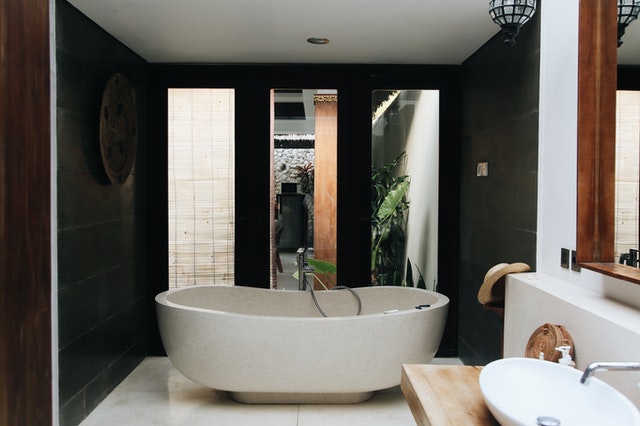
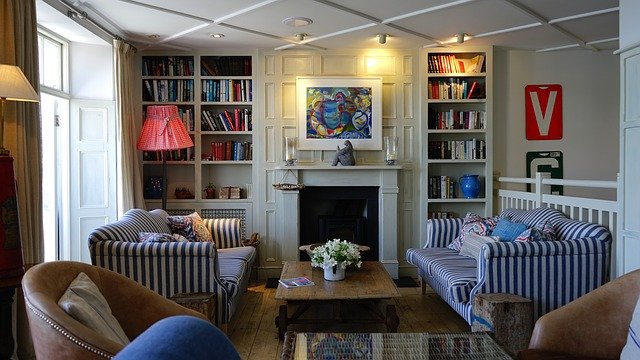
Slate Happens
Fireproof functionality
Countertop variety
Texture and tone
Under foot
An irregular pattern of slate tiles, each out-lined in wide white grouting, forms a walk-on surface ideal for dining outdoors on a patio decorated with plants.
With its unique appearance, slate is rarely mistaken for other types of stone. Although lacking the sleekness of other stone forms, slate has intrinsic strength, density, and durability that make it equally usable on fireplaces, floors, walls, and countertops, providing a surface that needs little maintenance. Its versatility is supreme, which is why it is used so often on roofs, driveways, potions, pathways, and pool surrounds. Slate’s most common colors are red, purple, tan, gray, green, and black. Like many natural stones, slate’s rich coloration derives from its mineral content, which includes quartz, silicate, chlorite, and some graphite, plus mica, calcite, and some graphite, plus mica, calcite, and trace quantities of numberless other minerals. The surface itself is not as hard as other stones, but it can be engraved easily.
Countertop variety
Although it is naturally water-resistant and requires sealing only after longtime heavy use, slate needs careful consideration when used as a work surface in a kitchen. It can create a rustic-looking surface of great beauty or one of smooth refinement, but in either case it can be easily chipped and scratched. Acid spills will not harm it, but in a kitchen—where a countertop receives daily use—a penetrating sealer is recommended. Choose one with a matte finish to ensure that the stone’s natural color is unaltered.
Ordering insights
- Never finalize a stone order based on looking at a single stone chip in a showroom; invest in three or four actual tiles to get a true picture of the color and pattern you prefer.
- Then let the installer add five to ten percent more stone than your blueprints suggest you need. There is always some waste when stone is cut and, occasionally, damage when the product is shipped.
- When your order arrives, inspect immediately to confirm its color and condition.
Texture and tone
Added to its versatility and durability is slate’s uniquely warm appearance, one that cannot be duplicated by any other type of stone. As a bonus, slate presents unrivaled earthiness and the colors apparent in individual widely, adding measurably, to this stone’s visual interest. Hand-splitting slate, when it is quarried, produces uneven sheets, so you may have to get used to its naturally cleft surface. Textural contrast results from pairing slate with glass, porcelain, and other more refined stone surfaces. True slate lovers tend to like the look.
Under foot
Slate chips have long been used to make garden paths that drain well and are easy underfoot. But slate’s indoor uses are becoming legendary, with installations that turn up not only in kitchens and baths—where water spills are frequent and undamaging—but also in entry halls, living and dining rooms, family rooms designed for kickback coziness, and stair treads and risers. That it’s as much at home inside a house as outside—as garden walls, patio surface, and pool surrounds—points up its extreme versatility. Decorative products also come into play; as slate can be shaped into chairs, benches, lamp bases, and tabletops.
Touch and feel
Slate’s texture is determined by its physical composition, but the actual surface can be altered. For example, rough surfaces can be achieved from these techniques:
- Split face: a cut that produces an uneven surface.
- Saw-cut: a rough-sawn look complete with saw marks.
- Flamed: damp stone chipped off by an acetylene torch.
- Sandblasted: a pitted look determined by the grit used.
A smooth surface can be achieved by the following:
- Honed: smooth to the touch but does not show wear and tear.
- Polished: a mirror-like sheen that is best on walls and other surfaces that don’t get abrasive contact.
